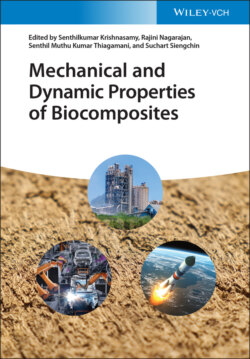Читать книгу Mechanical and Dynamic Properties of Biocomposites - Группа авторов - Страница 22
1.4.1.7 Cotton/Jute and Cotton/Kapok FRP Hybrid Composites
ОглавлениеCotton fibers have been considered as fibers with the greatest importance across the globe. They usually do not have branches and the seed hairs have a single cell (unicellular). They are also rich in cellulose and can elongate up to 30 mm. The wall of cotton fiber does not contain lignin, as distinct from the secondary cell walls of most plants [35]. Cotton fibers are used widely in the textile industry. They possess some advantages, which include excellent drape, high absorbency, as well as good strength.
In the study conducted by De Medeiros et al. [36], the mechanical behavior of woven fabrics of hybrid cotton/jute with phenolic matrix (novolac type) reinforcement was investigated. The results showed strong dependence on the mechanical behaviors on fiber content, fabric characteristics, fiber–matrix adhesion, and fiber orientation. The anisotropy of the composites increased when the test angle was increased and showed dependence on fiber roving/fabric characteristics. There was an inverse proportionality between the mechanical properties and the test angle as the best performance was obtained in the specimen tested at zero degree (that is, jute roving direction). Brittle failure, though controlled, was displayed in the composites that were tested at angles of 45° and 90° as jute fiber directions (Table 1.6), while at 0° to the longitudinal direction, the tested composites exhibited an uncontrollable catastrophic failure. Jute fiber was identified as a strong material for reinforcement and when combined with cotton could prevent catastrophic failure in the fabric composites. In addition, the results obtained from mechanical behaviors of cotton/kapok FRP hybrid composites are depicted in Table 1.7, showing the effects of accelerated and non‐accelerated weather conditions of alkaline‐treated and untreated specimens. The results of cotton/ramie FRP hybrid composites, with ramie fibers placed longitudinally to the mold length and various ratio, are also shown in Table 1.7.
Table 1.7 Mechanical behaviors of cotton/kapok, cotton/ramie, and jute/oil palm empty‐fruit bunches (OPEFB) FRP hybrid composites.
Source: Nguyen et al. [4]. © 2017, Elsevier.
| Hybrid biocomposites | Fiber ratio (by weight or volume) | Flexural modulus (GPa) | Flexural strength (MPa) | Tensile modulus (GPa) | Tensile strength (MPa) | Impact strength (kJ/m2) |
|---|---|---|---|---|---|---|
| Cotton/kapok | 3 : 2 | |||||
| Untreated (Vf = 60%) | — | — | 0.884 | 55.70 | 110.53 | |
| Alkali treatment (Vf = 43%) | — | — | 1.635 | 52.87 | 119.25 | |
| Non‐accelerated weather condition (Vf = 46.6%) | 0.709 | 52.40 | — | — | — | |
| Accelerated weather condition (Vf = 46.6%) | 0.703 | 39.55 | — | — | — | |
| Cotton/ramie (ramie fibers placed longitudinally to the mold length) | 10.8 : 41.1 (0° composite) | — | — | — | 90.9 ± 12.7 | — |
| 11.9 : 45.5 (0° composite) | — | — | — | 117.3 ± 13.3 | — | |
| 11.9 : 45.1 (0° composite) | — | — | — | 118.0 ± 6.5 | — | |
| Jute/OPEFB | 1 : 4 | |||||
| OPEFB/Jute/OPEFB | — | — | 2.39 | 25.53 | — | |
| Jute/OPEFB/Jute | — | — | 2.59 | 27.41 | — | |
| Pure OPEFB | — | — | 2.23 | 22.61 | ||
| Pure jute | — | — | 3.89 | 45.55 |
